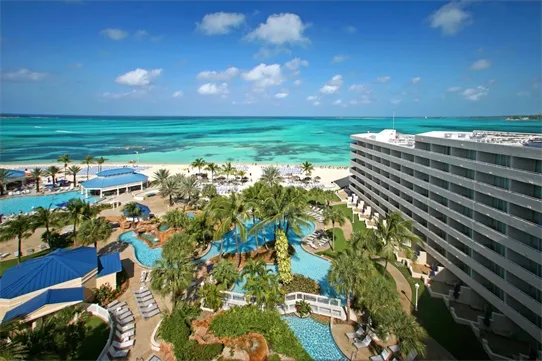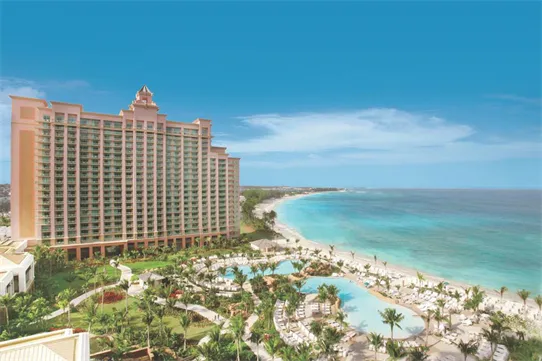Bahamas holidays
Glorious weather, great beaches and fantastic water sports make the Bahamas a destination that’s topped many a must-visit list. Close to the USA and part of the Caribbean (although technically in the Atlantic), you’ll find the Bahamas’ north-west point to be 760 miles off the Florida coast, with the island chain stretching towards Haiti in the south east.
Blush pink sand, azure shallows and inky blue depths - the coasts surrounding these incredibly beautiful islands have to be seen to be believed. Busy and bustling resorts sit alongside hidden coves and undisturbed sandy strips, making for a sunbathing, rock-pooling, wild swimming, snorkelling paradise. Grab a conch at one of the Bahamas’ many beachside food shacks, or a main meal in an open-air cabana overlooking the water. Wherever you go, you’ll find the seafood always has that just-caught taste and the Gully Wash always quenches that thirst after a long, hot day. The Bahamas are named after and famous for the shallow waters that surround it. Teenagers will love exploring the nearby caves, cenotes and reefs, while younger tots can splash about in the still waters. Take a whale-watching tour or charter a boat to explore the Exumas, and you might spot the swimming pigs and the sun-basking iguanas these beaches are famous for. The capital city of Nassau on the island of Grand Providence is the Bahamas’ most colourful city. Here you’ll find a range of modern bars, world-class restaurants and visitor attractions. Older folks can learn how to roll cigars, go on a rum-tasting tour or knock back a Sky Juice or two - a local drink made of coconut water and gin - while listening to an authentic rake and scrape band. As for PG activities, Aquaventure caters to big kids and toddlers with 141 acres of fun including rapid waterslides and shallow splash pools.
Travel guide
Weather & Climate
Fast facts:
Safety and Security:
For up-to-date advice on travelling to the Bahamas, please visit the FCDO website.Things to do
Cat Island is a glimmering jewel in the heart of the Bahamas. This small island is pristine and perfect, an ideal escape from it all.Harbour Island In The Bahamas
A small island sitting just off the edge of the larger Eleuthera in The Bahamas, Harbour Island will stun you with its pink sand beaches and outlying coral reefs.Bimini In The Bahamas
Bimini refers to a region of the Bahamas made up of two islands (North and South Bimini) and a clutch of cays, just 80km off the coast of Florida, which makes it the closest of the Bahamian islands to the USA.Coco Cay In The Bahamas
CocoCay, also known as Little Stirrup Cay, is a popular stop-off point on Royal Caribbean voyages, and is owned by the company for the exclusive use of its cruise customers.George Town
Located on the beautiful island of Great Exuma in the Bahamas, George Town is a small, but in island terms, significant town, with shops, a bank and a range of places to eat and drink.Explore Nassau Paradise Island Bahamas
; One of the most visited islands in the Bahamas is Paradise Island, just 2.8 square km of land off the northern coast of Providence Island, accessible via two bridges from the Bahamas’ capital city Nassau.Pink Sand Beach In The Bahamas
On the east side of the beautiful Harbour Island is one of the most renowned beaches in the whole of the Bahamas. The Pink Sand Beach is a visually stunning and remarkable coastal attraction that draws thousands of visitors from across the …Bahamas Nightlife: Bars & Clubs
From rustic beach huts playing local beats to city lights and non-stop activity, Bahamas nightlife brings you a world of contrasts.Bahamas travel money
The official currency in the Bahamas is the Bahamian dollar (BSD).The currency is often written as $B to differentiate it from other dollar currencies, which is particularly useful because of its close relationship to the US dollar. The Bahamian dollar is tied to the US dollar in terms of value, and on a practical level, the two are interchangeable in the Bahamas. Both are accepted in shops and businesses throughout the islands. In fact, the US dollar is sometimes even preferred, and may help you to barter down a Straw Market seller who’d rather have the American note. Visitors to the Bahamas from the US often say that it’s not worth changing currency into Bahamian dollars, since US dollars are so widely received. Casinos in the Bahamas only accept US dollars, with the house ATMs dispensing the American currency. You’ll find ATMs dispensing the islands’ native dollar in Nassau and on most of the outlying islands, although some don’t have this facility, most notably Elbow Cay, Acklins, Crooked Island and Inagua. It’s important to note that it’s not easy to get hold of Bahamian dollars in the UK. Your high street bureau de change definitely won’t carry them, so it’s easier to take US currency with you instead. Similarly, if you have Bahamian dollars left at the end of a trip, it’s best to try to spend them, since changing them back once you’re home is often not an option. Travellers cheques are still accepted in most resorts, tourist restaurants and attractions in the Bahamas Most hotels will change them into cash for you, usually for a small fee. The native currency in the Bahamas is available in half-dollar notes, as well as in denominations of 5, 10, 20, 50 and 100 dollars. A dollar is made up of 100 cents, with the coins being similar in appearance and value to their US counterparts. All notes used to feature Queen Elizabeth II on the front, but in recent years the Queen has been swapped out in favour of eminent Bahamian politicians. However, most modern notes now once again show the Queen, with the $100 note displaying the official fish of the Bahamas on the reverse. For this reason, you’ll often hear it referred to as a ‘blue marlin’.
Best hotels in Bahamas


